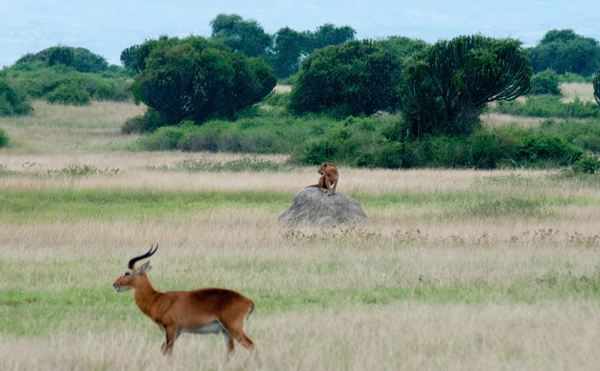You might have noticed that I’ve been a bit quiet (or at least brief) lately. That’s because I’ve been in Uganda for the last couple of weeks. As part of my work I travel to Africa fairly regularly. This sounds a lot more glamourous and exciting than it often is in practice. This time I wanted to see something beyond the hotel meeting room and the odd health facility, so Dr C and I tagged a safari onto the end of a work trip. We saw all sorts of exciting wildlife. As you can imagine, I took a few photos… well, around 1300… You’ll be relieved to hear I’m not going to put them all up here, but you may be a bit surprised by my choice of photos for this particular post…
I’m saving telling you about chimpanzees, tree climbing lions and hoards of hippos for another day. What I want to tell you about today is a little more down to earth: termite mounds.
I remember seeing termite mounds on my first trip to Africa, and after the first shock of realising just how big they can be in real life, I soon stopped noticing them. Look around a savannah landscape and they’re everywhere, like giant molehills.
This trip I started noticing them again. I started paying attention to one because a lion was sitting on top of it. Lions aren’t the only creatures who like to make use of termite mounds as a platform. We saw many antelopes of various sorts standing alert on top of termite mounds, using the additional height to help them spot far off predators. (Although, as Jamil, our guide, pointed out, this may not necessarily be a good idea, as it also makes them more visible to predators.)

Then, when we arrived at Lake Mburu National Park, I started noticing that many of the termite mounds were next to, or under, trees and bushes, dotted round the grassy plain. I wondered which came first – did termites prefer building mounds in the shade of trees? The answer, as one of the rangers told me, is that the termite mounds come first. Termites play an important role recycling dead vegetation. Dead plant material gets incorporated into termite mounds, making the soil of mounds fertile. Birds, like lions and antelope, enjoy perching of the mounds, and sometimes deposit their droppings there. These droppings often contain seeds, which germinate in the rich mound soil, turning old mounds into oases of shade in the grassland, which are used by many creatures, including leopards during the day.

Termites themselves are an important food for some animals. Every now and then we’d spot a big hole in a termite mound, made by an anteater. These holes then get used as dens by creatures like warthogs, bush pigs, and even hyaenas. Smaller creatures also use termite mounds as homes, like these dwarf mongooses (or is it mongeese?)


Termites are vitally important within savannah ecosystems, and they play an important role in shaping the landscape. Is there a British equivalent?



I enjoyed your appreciation and photos of the termite mounds. They are a prominent presence on the savannah, and you explained it well.
Thanks! That’s very kind of you. I’m very glad you enjoyed it.